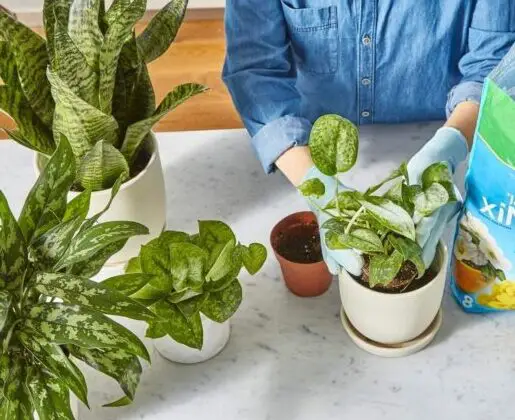Looking for the best soil for pothos? Look no further! Pothos, with its lush green leaves and air-purifying capabilities, is a popular choice among houseplant enthusiasts. And to keep this beautiful plant thriving, it all starts with the right soil.
So, what’s the secret? Well, the key lies in finding a well-draining soil mix that provides the perfect balance of moisture and nutrients. In this article, we’ll dive into the world of pothos soil, exploring the ideal composition and how to create it yourself. Get ready to take your pothos game to the next level!
Best Soil for Pothos: Creating the Perfect Growing Medium
Pothos, with its beautiful trailing vines and verdant leaves, is a popular houseplant known for its easy-care nature and ability to thrive in a variety of conditions.
To ensure your pothos plant flourishes, choosing the right soil is crucial. In this article, we will explore the best soil for pothos and discuss the important factors to consider when creating the perfect growing medium for your beloved plant.
Understanding the Needs of Pothos
Before delving into the specifics of the best soil for pothos, it is essential to understand the natural habitat and requirements of this tropical plant. Pothos, also known as Devil’s Ivy, is native to the forests of Southeast Asia. In its natural environment, pothos typically grows as an epiphyte, meaning it attaches itself to trees or other structures and absorbs nutrients from the air and rainwater.
As a houseplant, pothos retains its adaptable nature and does not demand overly complicated soil requirements. However, providing the right soil composition will optimize its growth and overall health. The ideal soil for pothos should mimic the well-draining, loose, and nutrient-rich environment of its natural habitat.
Key Considerations for the Best Pothos Soil
When selecting the best soil for your pothos plant, keep the following factors in mind:
1. Drainage:
Pothos plants dislike sitting in waterlogged soil, as it can lead to root rot and other fungal diseases. Good drainage is crucial to maintaining healthy roots. Look for a soil mix that allows excess water to flow through freely.
2. Moisture Retention:
While proper drainage is essential, it is equally vital to choose a soil blend that retains some moisture without becoming overly saturated. Pothos plants prefer slightly moist soil, but they also benefit from periodic drying out between waterings.
3. Nutrient Content:
Pothos plants have moderate nutrient requirements. A soil mix that provides a balanced blend of essential nutrients will promote healthy foliage growth and vibrant colors. Additionally, a soil enriched with organic matter can enhance nutrient availability and microbial activity in the root zone.
4. pH Level:
Pothos plants prefer slightly acidic to neutral soil conditions. A pH range between 6.1 and 7.0 is ideal for allowing optimal nutrient uptake. It is important to note that pothos plants can tolerate a wide range of pH levels, but extreme acidity or alkalinity may hinder nutrient absorption.
5. Aeration:
Proper aeration in the soil is vital for pothos plants. Oxygen is necessary for healthy root growth and nutrient absorption. A well-aerated soil mix prevents compaction and promotes an optimal balance of air and water in the root zone.
Now that we have covered the key considerations for the best soil for pothos, let’s explore some popular soil options and their characteristics that can support your pothos plant’s growth.
1. Peat-Based Soil Mix
Peat-based soil mixes are a popular choice for pothos plants due to their excellent water retention properties and ability to provide adequate drainage. These mixes usually consist of peat moss, perlite, and vermiculite, creating a well-balanced medium for pothos to thrive.
Peat is an organic material that holds moisture without becoming waterlogged, while perlite and vermiculite enhance drainage and aeration.
Pros of Peat-Based Soil Mix:
- Retains moisture while allowing excess water to drain
- Provides good aeration and prevents compaction
- Rich in organic matter, promoting nutrient availability
- Readily available in garden centers and nurseries
Cons of Peat-Based Soil Mix:
- May become acidic over time, necessitating periodic pH monitoring and adjustment
- Peat moss harvesting may have environmental concerns
2. Potting Soil Mix with Perlite
Potting soil mixes blended with perlite are another excellent choice for pothos plants. Perlite is a volcanic glass that has been heated at high temperatures, creating lightweight, porous particles. When added to potting soil, perlite improves drainage and facilitates oxygen penetration into the root zone.
Pros of Potting Soil Mix with Perlite:
- Aids in drainage and prevents waterlogging
- Enhances aeration and root development
- Lightweight and easy to work with
- Widely available and affordable
Cons of Potting Soil Mix with Perlite:
- May require more frequent watering due to increased drainage
- Less moisture retention compared to peat-based mixes
3. Soilless Mixes
Soilless mixes, also known as hydroponic or coco coir mixes, have gained popularity among indoor plant enthusiasts, including pothos growers. These mixes are made primarily from coconut husk fibers, offering excellent water retention and drainage properties. They are lightweight, sterile, and often pH-neutral, making them an attractive option for pothos plants.
Pros of Soilless Mixes:
- Superior water retention and drainage capabilities
- Nutrient-rich and promotes healthy root development
- Lightweight and easy to handle
- Coconut coir production is considered environmentally friendly
Cons of Soilless Mixes:
- May require additional fertilization due to leaching of nutrients
- Can dry out more quickly compared to other soil mixes
Creating the Perfect Soil Blend
While the above options are excellent choices on their own, many indoor gardeners prefer creating custom soil blends tailored to their specific needs. Here is a simple recipe for creating a well-draining and nutrient-rich soil mix for pothos:
Ingredients:
- 2 parts peat moss or coco coir
- 1 part perlite or vermiculite
- 1 part compost or well-decomposed organic matter
Directions:
- In a large container, combine the peat moss or coco coir, perlite or vermiculite, and compost or organic matter.
- Thoroughly mix all the ingredients until well-blended.
- Transfer the soil blend into a clean container or use it directly for potting your pothos plant.
Customizing your soil mix allows you to fine-tune the ratio of components based on your pothos plant’s specific requirements. Remember to periodically monitor the pH level of your soil and make adjustments if necessary.
Refreshing Soil and Repotting
Over time, the soil in your pothos plant’s container may become compacted or depleted of nutrients. Refreshing the soil and repotting your pothos every 1-2 years can help maintain its health and vigor. Follow these steps for a successful repotting process:
- Carefully remove the plant from its current container, gently loosening the root ball without causing damage.
- Inspect the root system for any signs of rot or disease and trim away any damaged or unhealthy roots.
- Choose a slightly larger pot with good drainage holes.
- Prepare a fresh batch of the soil mix suited for pothos.
- Place a layer of the new soil mix at the bottom of the new pot.
- Position the pothos plant in the center of the pot and fill the remaining space with the soil mix, ensuring it is evenly distributed around the roots.
- Gently firm the soil around the plant and water thoroughly.
Repotting not only provides an opportunity to refresh the soil but also allows your pothos plant to grow and expand its root system, promoting overall vitality.
Choosing the best soil for your pothos plant is essential for its long-term health and success. By considering the key factors of drainage, moisture retention, nutrient content, pH level, and aeration, you can create an optimal soil blend that mimics the natural environment of pothos.
Whether you opt for peat-based mixes, potting soil blends with perlite, or soilless mixes, the goal is to provide a growing medium that strikes the perfect balance of moisture, nutrient availability, and aeration.
Regularly refreshing the soil and repotting your pothos will ensure its continued growth and vibrancy, rewarding you with lush foliage and a thriving plant. Happy pothos growing!
Frequently Asked Questions (FAQs)
Pothos plants thrive in well-draining soil that retains some moisture. A mixture of potting soil and perlite or sand can provide the ideal growing medium for pothos.
It is not recommended to use regular garden soil for pothos plants. Garden soil tends to be denser and may retain too much moisture, leading to root rot. Opt for well-draining potting soil instead.
While there is no specific brand of potting soil required for pothos, choosing a well-draining and nutrient-rich mix is essential. Look for potting soil labeled for indoor plants or one suitable for tropical plants.
Yes, you can create your own soil mix for pothos. A common recipe includes equal parts of peat moss, perlite, and compost. This mix provides good drainage and retains enough moisture for healthy pothos growth.
Pothos plants prefer a slightly acidic to neutral soil pH range of 6.1 to 7.0. It is important to maintain the pH within this range for optimal growth and nutrient absorption.
Cactus soil is not typically recommended for pothos plants. Cactus soil is designed for plants that require extremely well-draining soil, while pothos prefer a slightly moister environment. It is best to use a well-balanced potting mix instead.
Using a soilless mix, such as a mixture of peat moss and perlite, can be beneficial for pothos. It helps improve drainage and prevents soil compaction, allowing the roots to breathe and grow effectively.
Yes, vermiculite can be added to the soil mix for pothos. It helps retain moisture without becoming soggy and aids in providing a well-draining environment for the roots.
However, be sure not to overdo it, as too much vermiculite can lead to waterlogged soil.
Final Thoughts
The best soil for pothos is well-draining and rich in organic matter. A combination of peat moss, perlite, and potting soil provides the ideal growing medium for pothos plants. This mixture ensures that excess water can easily drain away, preventing root rot. The organic matter in the soil helps to retain moisture and provides essential nutrients for healthy growth.
When repotting or propagating pothos, it is crucial to use a well-balanced soil mix that promotes root development and overall plant health. Choosing the right soil is essential for the successful cultivation of pothos plants.
Auto Amazon Links: No products found.
Perfect Plants Christmas Tree Saver 8oz. | Easy Use Xmas Tree Preserver Food | Have Healthy Green Christmas Trees All Holiday Season
$9.97 (as of December 13, 2025 05:07 GMT +00:00 - More info- Product prices and availability are accurate as of the date/time indicated and are subject to change. Any price and availability information displayed on [relevant Amazon Site(s), as applicable] at the time of purchase will apply to the purchase of this product.
Rocky Mountain Goods Christmas Tree Food - 8 oz Tree Preservative - Reduce Needle Drop - Greener Scent - Fir, Pine, Spruce Trees - Extend Tree Life
$9.95 (as of December 13, 2025 05:07 GMT +00:00 - More info- Product prices and availability are accurate as of the date/time indicated and are subject to change. Any price and availability information displayed on [relevant Amazon Site(s), as applicable] at the time of purchase will apply to the purchase of this product.
FirEver Pure Christmas Tree Food | Preserver Additive & Season Extender for Live Xmas Trees | Keep It Green, Reduce Needle-Drop | Miracle Freshness (8 oz)
$14.99 (as of December 13, 2025 05:07 GMT +00:00 - More info- Product prices and availability are accurate as of the date/time indicated and are subject to change. Any price and availability information displayed on [relevant Amazon Site(s), as applicable] at the time of purchase will apply to the purchase of this product.
VICAMB 39.3 Inch Christmas Tree Watering Funnel,Christmas Tree Watering System Device,Long Tree Watering Funnel Spout for Indoor Outdoor Xmas Tree
$16.99 (as of December 13, 2025 05:07 GMT +00:00 - More info- Product prices and availability are accurate as of the date/time indicated and are subject to change. Any price and availability information displayed on [relevant Amazon Site(s), as applicable] at the time of purchase will apply to the purchase of this product.
EZMeetU Christmas Tree Watering Funnel, 47 Inch Flower Shape Adjustable 6 Section Design, Christmas Tree Watering System, Christmas Tree Waterer, Long Funnel Wide Opening Reusable, Plant Watering Tool
$16.99 (as of December 13, 2025 05:07 GMT +00:00 - More info- Product prices and availability are accurate as of the date/time indicated and are subject to change. Any price and availability information displayed on [relevant Amazon Site(s), as applicable] at the time of purchase will apply to the purchase of this product.
Snow Joe Premium Enviro Blend Ice Melt, Green-Coated Deicer Crystals, 50 lb - Safer Melter for Vegetation, Concrete & Metals w/ Anti-Corrosion Calcium Magnesium Acetate
$32.97 (as of December 12, 2025 19:27 GMT +00:00 - More info- Product prices and availability are accurate as of the date/time indicated and are subject to change. Any price and availability information displayed on [relevant Amazon Site(s), as applicable] at the time of purchase will apply to the purchase of this product.
Muddy Mat® Shown on TV Super Absorbent Microfiber Dog Door Mat for Muddy Paws, Non-Slip Washable Pet Rug, Quick Dry Chenille Entryway Carpet, Machine Washable Indoor Outdoor mat, Grey 30"x19"
$24.95 (as of December 12, 2025 19:27 GMT +00:00 - More info- Product prices and availability are accurate as of the date/time indicated and are subject to change. Any price and availability information displayed on [relevant Amazon Site(s), as applicable] at the time of purchase will apply to the purchase of this product.
ivtivfu Rolling Grill Basket, Removable Wooden Handle, 304 Stainless Steel, Nesting BBQ Tools, Smoker Grilling Accessories for Vegetable, Outdoor Cooking Camping, Birthday Gifts for Men Dad Husband
$25.99 (as of December 12, 2025 19:27 GMT +00:00 - More info- Product prices and availability are accurate as of the date/time indicated and are subject to change. Any price and availability information displayed on [relevant Amazon Site(s), as applicable] at the time of purchase will apply to the purchase of this product.
XXXFLOWER Plant Terrarium with Wooden Stand, Air Planter Bulb Glass Vase Metal Swivel Holder Retro Tabletop for Hydroponics Home Garden Office Decoration - 3 Bulb Vase
$18.98 (as of December 12, 2025 19:27 GMT +00:00 - More info- Product prices and availability are accurate as of the date/time indicated and are subject to change. Any price and availability information displayed on [relevant Amazon Site(s), as applicable] at the time of purchase will apply to the purchase of this product.
Zevo Flying Insect Trap Official Refill Cartridges - Fits Both Zevo Trap & MAX Indoor Fly Trap - Authentic Trap+Lock Technology to Catch Gnats, House & Fruit Flys (4 Official Refill Cartridges)
$14.97 (as of December 12, 2025 19:27 GMT +00:00 - More info- Product prices and availability are accurate as of the date/time indicated and are subject to change. Any price and availability information displayed on [relevant Amazon Site(s), as applicable] at the time of purchase will apply to the purchase of this product.











